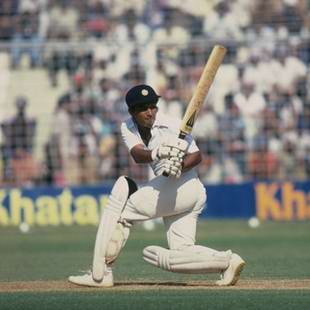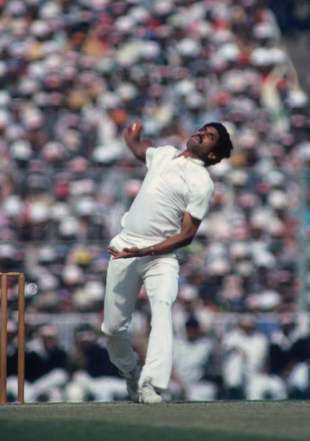
|

Sunil Gavaskar didn't hang about at Berbice, unlike in his infamous World Cup innings in 1975
© Getty Images
|
|
Twenty-five years on, it still remains a source of wonder how Kapil Dev's bunch of
no-hopers managed to capture the 1983 World Cup. India's showings at the previous
World Cups had made for sorry reading: no wins against significant opposition, and Sunil
Gavaskar's tedious, unbeaten 36 off 174 balls in 1975 was perhaps the only
talked-about individual contribution.
The foundation for the success was laid not in a high-profile match at one of
cricket's marquee venues but in an inconspicuous
one-dayer tucked away in the middle of a Test
series, at the humble Albion Sports Complex in Berbice, Guyana.
A few months before the World Cup, India had embarked on one of cricket's toughest
assignments - a tour against Clive Lloyd's West Indies. Apart from having to line up against a veritable who's who of one-day batting greats backed up by what is widely regarded as the most fearsome bowling combination in history, the Indians had several other issues to contend with: their long-standing captain, Gavaskar, had just been sacked
after a disastrous tour of Pakistan, there was talk of a rivalry between West Zone
and North Zone players in the team, they had an non-threatening bowling attack, and
were missing the big-hitting Sandeep Patil - their best ODI batsman on the Pakistan
tour.
Having lost the first Test and ODI and drawn the second Test, they came to Berbice, where there were some factors in their favour. Firstly, the pitch was flat. "In fact, Lloyd was rather unhappy about this," recalls Ashis Ray, a veteran commentator and writer who covered the tour. "But in those days, the West Indian quicks used to mow through any batting line-up even on a slow track." Also, Berbice, where the great Rohan Kanhai was born, was home to thousands of Guyanese of Indian descent, who turned up in large numbers to support the visiting side. "Temporary stands had been erected to accommodate the spectators," says Ray. "It was Holi [an Indian festival], and therefore a festive atmosphere existed among the Indo-Caribbeans in the crowd."
After India were sent in by Lloyd, Gavaskar conjured one of his finest one-day
knocks. His performance in the World Cup would be dismal, but he expertly handled the West Indian pace quartet in this game. With Ravi Shastri, who was opening for the first time in an ODI, holding firm at the other end, Gavaskar's wonderfully paced effort ensured the scoring-rate remained above five. He fell short of becoming India's first one-day centurion, run-out for 90 off 117 balls but left India at 152 for 2, primed to exploit the one chink in the opposition bowling - their feeble spin department.
That weakness was exposed by Kapil in a hurricane knock of 72 off 38 balls, carving three sixes and seven fours on the way and lifting India to 282 for 5 in 47 overs, their highest score till then in ODIs.
He then came back with the new ball and, along with Balwinder Sandhu, got rid of the dreaded opening pair of Desmond Haynes and Gordon Greenidge early. Still, as it would be in the World Cup final, the match seemed to be slipping out of India's grasp as Viv Richards tore into the bowling.

|

Kapil Dev starred with ball and bat - a precursor of his World Cup performance
© Getty Images
|
|
Richards crashed a manic 64 before being bowled by Madan Lal, but India faced some more anxious moments as wicketkeeper Jeff Dujon and Faoud Bacchus made tenacious half-centuries. Shastri then chipped in with three wickets and Kapil and Sandhu wrapped up the tail. It was a collective bowling effort - foreshadowing the performance at the World Cup - that helped India to a 27-run victory.
It was a landmark win - India's first ODI victory against the West Indies, and the
first time a full-strength West Indies had been beaten at home. However, due to the
low-profile nature of one-dayers then and the defeat in the Test series that followed (India lost 0-2), the Indian public didn't really pick up on the win. "I don't think many people realised the enormity of the win straightaway," says Ray. "But the Berbice victory lent the team massive self-belief, which they quietly carried into the World Cup - only 11 weeks later."
The players, especially Kapil, were keenly aware of the importance of Berbice. "We learnt quite a few lessons on this sunny day and our confidence started building up right away." Kapil wrote in his autobiography Straight From the Heart. "It's this
particular win that helps convince many of us that we may well be able to pull our
weight together as a team."
The other members of the squad were also buoyed by Kapil's confidence. "Looking
back, I can vividly recall the talk Kapil Dev had with the team before the World Cup
started," Kris Srikkanth, the former Indian opener, wrote. "He made us believe that the West Indies were beatable. We had got a win a few months earlier and Kapil said if we could do it once, why not another time." That belief burgeoned as an unfancied but upbeat India kicked off an unforgettable campaign by vanquishing the favourites, West Indies,
at Old Trafford.
Siddarth Ravindran is an editorial assistant at Cricinfo



